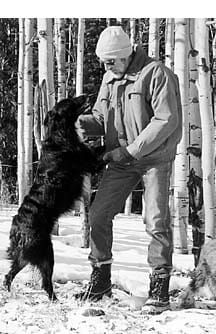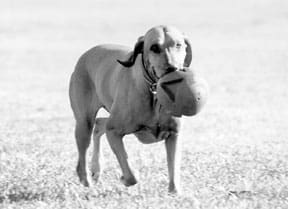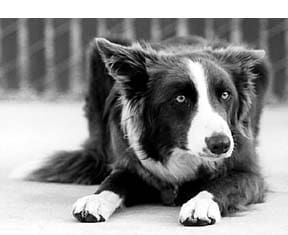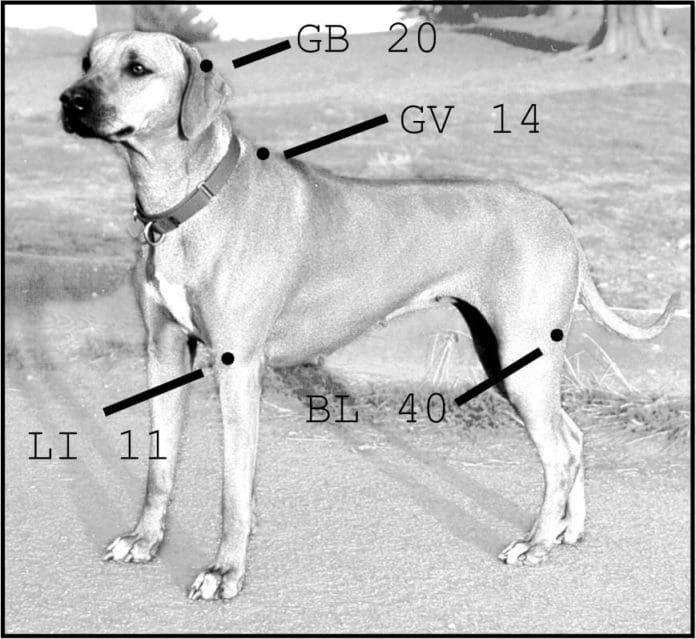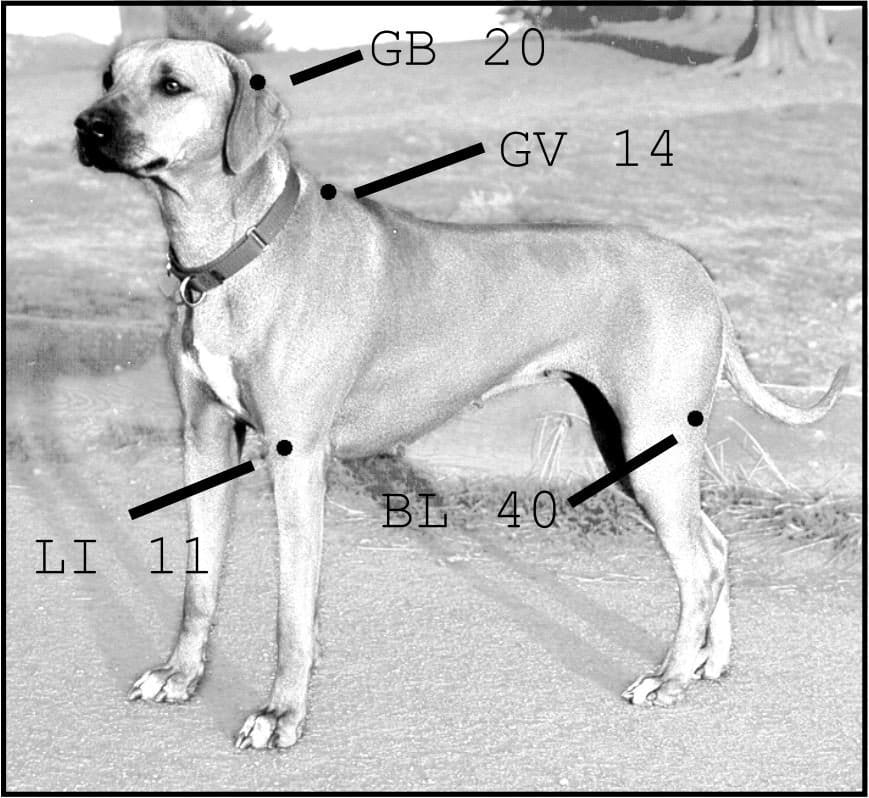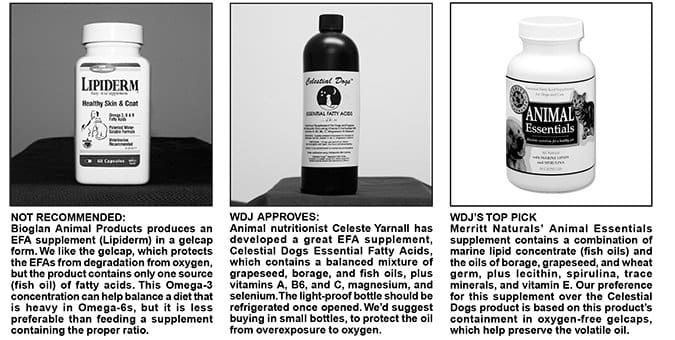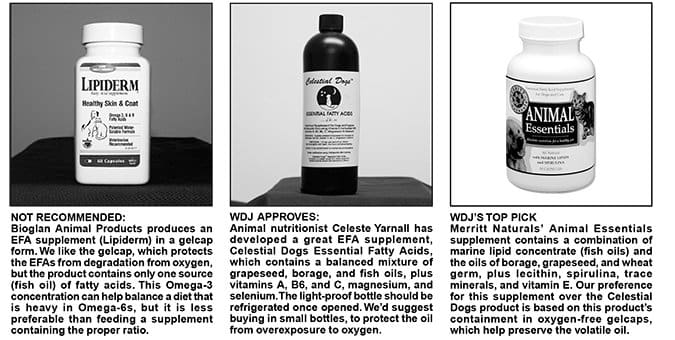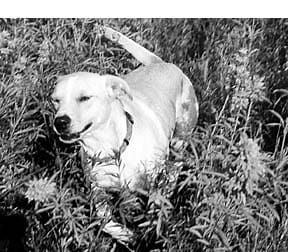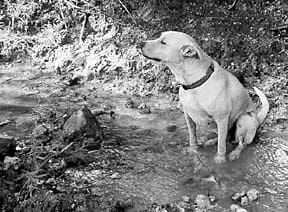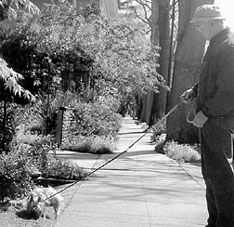You’ve played this game thousands of times. You’ve got a few minutes, and your maniacally loyal canine companion is eager to play fetch, begging for it, ball in mouth, dropping it at your feet, barking in joyful anticipation. Like the thousands of times before, you pick up the slobbery orb, and launch it once, twice, 10 times, 20 times.
Rod Rogers recalls one such day, a day different from hundreds of others that preceded it because of a freakish accident. The bone-chilling cold November day was not unusual for that time of year, not in the sagey hills of Gunnison, Colorado, at 7000 feet elevation, where Rogers and his family live. “We’d gotten some snow, so I was outside shoveling,” Rogers remembers. “To keep Willie, our five-year-old Border Collie, from diving at the snow I was throwing off my shovel, I’d stop every few digs and throw the ball. Pitch, run, catch, return. Pitch, run, catch, return. As usual, Willie was going for the ball at 110 percent.”
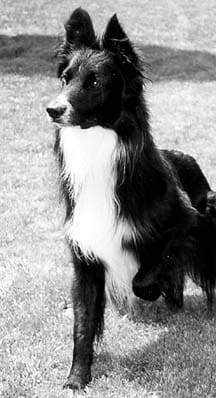
Then it happened. Willie slipped, tried to stop, and twisted into a ball with a yelp. He lay paralyzed from the middle of the back down, lying quietly on the frozen ground as Rogers rushed over.
“Though he was immobilized, he didn’t seem to be in pain,” Rogers describes. “My wife, Mari, is a nurse. She slowly ran her hands over Willie’s body to feel for broken bones. We carried him carefully into the house, and tried to call our vet.”
But it was after hours, and the vet’s office was closed. With no emergency clinic within striking distance, and since Willie didn’t seem uncomfortable, his owners decided to keep the dog under close observation, letting him rest until the next day when the clinic would open. The couple were encouraged when the dog drank some water, and carried by his owners, even managed to relieve himself outside.
First thing the next morning, the couple carried Willie to the car and took him to see their veterinarian, Dr. Tim Holt at the Town and Country Veterinary Clinic in Gunnison.
How bad is it, Doc?
Technicians took Willie’s vital signs, and noted that he’d refused food since the accident the day before. Dr. Holt physically examined Willie, looking at his eyes and gums to check for shock, and running his hands over the Border Collie’s wiry body to check for broken bones or swellings.
Interestingly, the reflexes in Willie’s hind legs were fine. In response to a pinch of his hind leg, Willie quickly turned his head, reaching back to see what had “bit” him. That was good news! Most important to the neurological exam was Dr. Holt’s finding that Willie could still perceive “deep pain,” which indicated that the spinal cord was not severed, perhaps merely bruised. No broken or fractured bones were revealed in the X-rays, but the films couldn’t confirm the diagnosis that Dr. Holt suspected: either a herniated disc (the cartilage between the backbones) or pinched nerve.
A spinal disc is a cushion that sits between the vertebral bodies of the spinal column and acts like a shock absorber. It’s made up of a rim of tough cartilage that has a gel-like center. When a disc herniates there is a break in the fibrous capsule that allows the inner nucleus of the disc to push through the opening and pinch the cord or put pressure on the dorsal nerve roots. Herniated discs commonly give rise to pain, weakness, paralysis, or loss of sensation.
Dr. Holt told the Rogers that they would have to take Willie to a clinic where a myleogram or magnetic resonance image (MRI) could be used to unequivocally diagnose Willie’s problem. These sophisticated tests would help explain specifically what had happened to Willie, which would then influence routes to treatment. A myleogram entails injecting contrast material into the spinal canal to reveal the herniation on X-rays. Surgery may be indicated if the herniation were severe enough.
Treatment tailored for the dog
The couple discussed their options. The closest clinic that could conduct the tests suggested by Dr. Holt was in Denver, a five-hour, winter drive over icy mountain passes; diagnosis and treatment at such a clinic would also entail a huge expense.
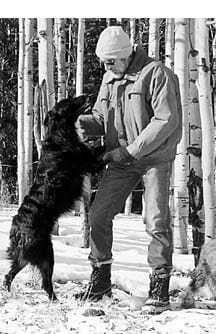
Then there was Willie himself, not a great candidate for care at a large veterinary facility, especially one where he would be left in the care of a rotating crew of strangers. “This dog is the happiest animal we’ve ever seen, and yet, by nature he’s extremely shy, unusually reluctant to get to know somebody,” explains Rod. The couple agreed that the high-strung Border Collie might well wither in such an environment. Given these obstacles, the couple urged the doctor to try whatever he could, right there, right then.
“We felt that Dr. Holt is not just a medical technician; he’s a healer, and he exudes compassion and caring,” says Rod. “Willie picked up on that. So, when Dr. Holt listed our options, and one of them was treating Willie with a combination of conventional and complementary procedures, it made sense to us. We agreed to go ahead with steroidal therapy and enforced rest, to be followed by gentle massage and acupuncture.”
The couple left Willie at the Town and Country Veterinary Clinic, in the care of Dr. Holt. The veterinarian’s initial care for the suspected herniated disc was completely traditional. It began with administration (every six hours) of intravenous dexamethasone, a corticosteroid that would help stabilize the damaged capillary membranes and possibly prevent further swelling and inflammation. To prevent gastrointestinal complications due to the dexamethasone, he administered doses of Pepcid AC orally for the 24 hours that the steroid was administered.
By the morning of the second day in the clinic, Willie was able to bear weight on his left rear leg, but his right rear leg was still limp. Dr. Holt changed Willie’s medications from IV to an oral steroid in decreasing doses, along with Tagament to prevent stomach upsets.
Home recovery
Four days after his accident, Willie was sent home with his folks, still dragging his right rear leg, but able to bear weight on his left side. Dr. Holt strongly cautioned the couple to keep the Border Collie resting and quiet, and to administer the oral steroid and Tagament. Willie was also to come back to the veterinarian’s office for re-exam in a week.
Once a disc has been injured, healed, and calcified, the disc itself and surrounding areas may stay vulnerable to injury, setting the scene for chronic disc problems. While the area should be protected against unusual stress or strain, to fully heal the injury, circulation should be promoted. For this purpose, Dr. Holt showed the Rogers some very general massage strokes, long, smooth strokes paralleling Willie’s spine to promote circulation. Rod found the massage routine easy; in the evening he could sit for hours in his favorite chair watching TV, with Willie totally relaxed and stretched out alongside.
Though improving, Willie’s right leg still dragged when he walked a week later, and his foot was sore. The Rogers took pains to keep Willie calm and quiet, to try and keep him off his weak leg allowing his sore foot to heal. The dosage of steroids was decreased yet again, and plans for acupuncture treatment were outlined.
By three weeks after his accident, the Border Collie had regained about 90 percent use of his left rear leg, and about 75 percent of his right. Dr. Holt began acupuncture treatments, immediately accelerating Willie’s healing. Within two weeks, Willie was so much better that the steroids were completely discontinued, and Willie was permitted to begin light exercise again. Soon Willie was begging to join his family in one of his favorite activities, cross country skiing! (They allowed the eager dog to join them for a very short ski, just to let him feel included again.) “Willie was back to his usual 110 percent, which was exciting for us all, but we had to monitor him to make sure he didn’t overdo it,” Rod recalls.
The Rogers brought Willie to Dr. Holt’s office for acupuncture treatments every three weeks, and later, every four weeks, for several months. Massage continues on an “as needed” basis, when Willie looks tired, a little limpy, or just for fun and bonding.
Some seven months later, Willie has about 95 percent use of his left rear leg, and about 90 percent use of his right rear leg. As Rod says, “Border Collies were bred to be working dogs, and Willie still has to ‘work’ and be active. His gait is a little gimpy while walking, but at a gallop, you’d never guess he had been compromised in any way. Now that summer is here and it’s hiking season, Willie is with us on the trails, right at our heels.” A big challenge, say the Rogers, is to keep the over-eager Border Collie from wearing himself out; he does limp if he overexercises.
And, of course, resisting his invitations for a game of fetch when it’s icy!


